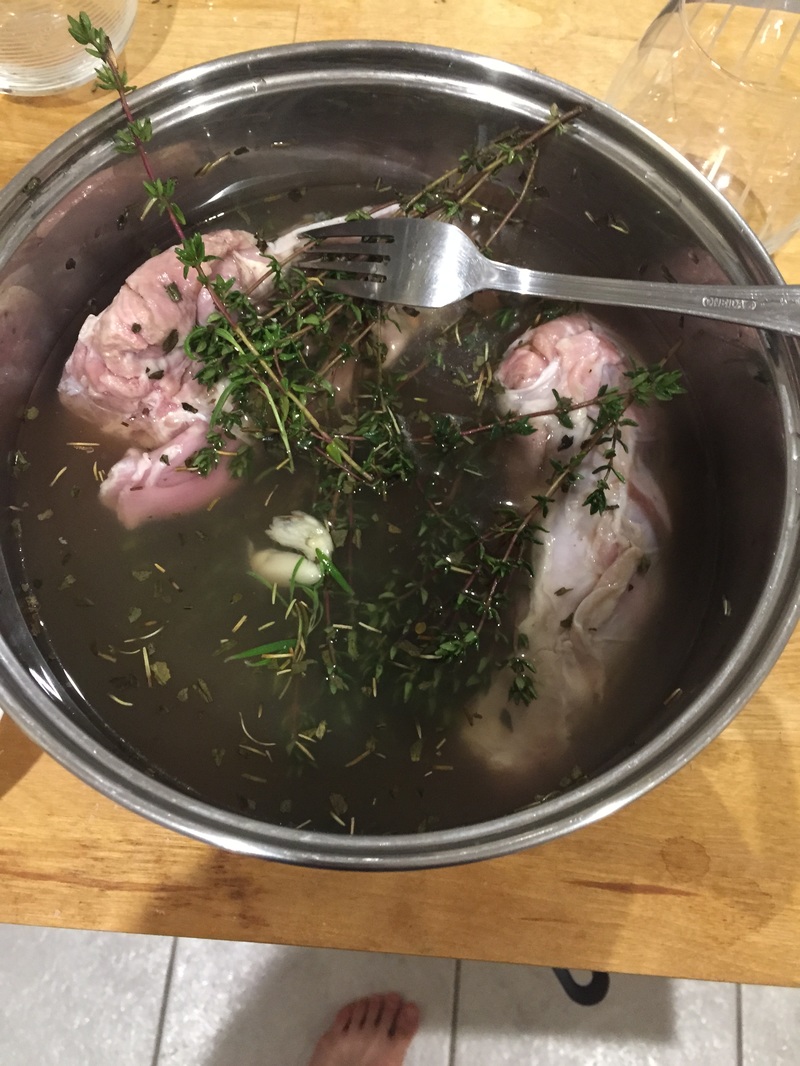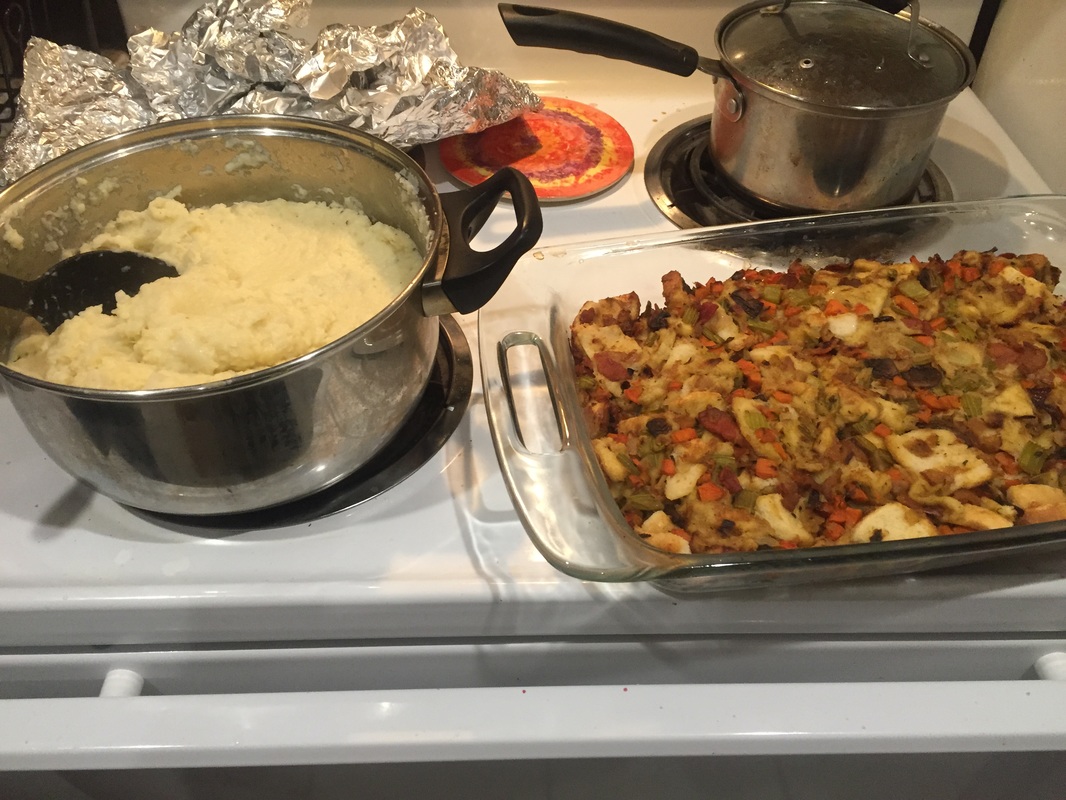This year, I spent Thanksgiving in Boston with my sisters. Usually, my mom does the majority of the cooking, so this year, all of the work was up to us. We went shopping the day before for all of our supplies. We made plans to make some turkey, gravy, cranberry sauce, salad, sweet potatoes, mashed potatoes, green bean casserole, and pumpkin pie. On Thursday morning, we made a list of everything we needed to cook during the day while watching the Macy's Day Parade. For first time Thanksgiving chefs, I think we did a pretty good job. Here are our results! Hope you all had a spectacular Thanksgiving full of gratitude, family, and food!
|
If you visit any Chinese restaurant in the U.S., dumplings are one of the items that you can be sure to find on the menu. They are beloved by many people, both those who are familiar with Chinese cuisine and those who are new to it, and for a good reason. Dumplings are delicious and easy to eat. In addition, they are a great dish for people who have never tried Chinese food before and are unsure of what to expect. In fact, I have so many friends that love dumplings, that many of them have asked me to teach them how to make their own dumplings at home. The recipe you'll find below is the recipe I have given to all of my friends and is a recipe that has been shared with people all over the world. On the surface, dumplings seem like a very simple dish, just some meat wrapped into a tiny piece of dough, right? Wrong! Dumplings have a long and interesting history that is rooted in Chinese culture and traditions. Dumplings, or 餃子 (Jiaozi), originated in Northern China where the diet is much more flour based than rice based, as it is in Central and Southern China. Traditionally, they were eaten only during Chinese New Year because most Chinese peasants could not afford to eat such rich and delicate foods year-round. People now eat dumplings throughout the year, but they are still specifically prepared for the Chinese New Year because they have traditional tidings of good luck and riches. Eating dumplings during the New Year are thought to bring good fortune for the coming year for two auspicious reasons. First of all, the shape of a dumpling is similar to a golden ingot which was used as currency in China until the 20th century. Secondly, the Chinese word for dumpling, 餃子 (Jiaozi), has the same pronunciation as the Chinese word for ancient paper money, 交子 (Jiaozi). As a result, Chinese families like to prepare and eat dumplings at the beginning of each year as tidings of prosperity for the rest of the year. My dad has a lot of memories of helping his mom make dumplings for dinner guests. My paternal grandfather was a diplomat for the Taiwanese government. As a result, my father spent many of his childhood years moving around the world with his family on different diplomatic assignments. From the age of 8 to the age of 18, my dad and his family spent time in different African countries like Sierra Leone and Milawi as ambassadors. During this time, my grandfather would spend the day with government officials in the office and would then invite them over for dinner to experience authentic Chinese cuisine prepared by my grandmother. The opportunity for African officials to experience homemade Chinese food during the 1960's was rare, so my grandmother always made sure to prepare delicious and easy to eat dishes. Dumplings were one of these dishes. My father has told me that he would always be recruited to help my grandmother make the dumplings because it is such a labor-intensive dish to make from scratch. While my grandmother prepared the meat filling for the dumplings, my father would be at the other end of the table mixing all of the ingredients needed to make the dough. When they were both finished with their respective duties, they would begin wrapping. Together, the two of them created a little assembly line. While my father rolled small chunks of dough into perfectly round wrappers, my grandmother would fill and wrap a dumpling. They would repeat this process until hundreds of dumplings had been made. The dumplings that my grandmother and my father made together were always a hit with the government officials and were made on many occasions. Dumplings can be made in a number of different ways. Traditionally, the filling for Chinese dumplings is made from pork and/or beef. Additionally, vegetarian dumplings can be made with a tofu, vegetable, or egg filling. The wheat-based wrapper is also traditionally handmade from dough. However, many companies now make packaged dumpling skins that are available in most Chinese markets and even in some American grocery stores. These skins are what my family now uses to make our dumplings on Chinese New Year because they are much more convenient and just as tasty. The actual wrapping of a dumpling is probably the most difficult part of making a dumpling for someone who has never done it before. However, the process is very easy after you do it once. There are multiple ways to seal the edges of a dumpling. The easiest way is to simply fold the wrapper in half and press firmly down around all of the edges until the dough adheres to itself. As a child, I was taught to use a crimping method that keeps the dumpling in a pretty crescent shape. However, this method is a little more difficult. If you want to see how I wrap a dumpling, please watch the video below. Regardless of how you choose to wrap your dumplings, the secret to making sure they don't fall apart is to "paint" the outer ring of the dumpling wrapper with a raw egg mixture, to create a natural glue. Credit: tastypursuits My family uses the same dumpling recipe that my grandmother used when they were in Africa with the exception of store bought wrappers. For the filling, we combine ground pork, ground beef, thinly sliced scallions, diced water chestnuts, garlic, ginger, salt, pepper, sesame oil, and an egg. My grandmother used scallions instead of the more traditional Chinese garlic chives because they were not available in Africa. If you would like to make your own dumplings, check out my family's recipe below! Once you become more confident in your skills, you can put your own spin on the dish or try out different variations of the filling like substituting scallions with napa cabbage. Chinese Dumpling RecipeChinese Dumplings
· 1 package dumpling wrappers · 1 lb. ground pork · ½ lb. ground beef · 2 eggs · 15 stems of fresh scallion · 1 can of water chestnuts · 3 cloves garlic · 2 tablespoons of finely chopped or grated ginger · 1 tablespoon sesame oil · 3 teaspoons salt · ½ teaspoon pepper Wash and clean all of the vegetables. Slice the scallions as thinly as possible. They should be almost translucent. Mince the garlic. Dice up the water chestnuts so that they are very small, yet large enough to provide some crunchy texture. Whisk the eggs (scrambled sounds like you cooked them) and then set aside 1/3 of the egg mixture. Combine all of the ingredients in a large bowl and mix everything thoroughly. Don't be afraid to use your hands to ensure that the filling is mixed evenly. Once everything is mixed, you are ready to start wrapping. Use the egg mixture that you set aside earlier to line the edges of the dough to ensure that your dumpling won't fall apart later. If you need assistance wrapping, please refer to the video above. Place each wrapped dumpling on a well floured board, ensuring that none of the dumplings are touching one another to avoid sticking. When you are finished wrapping, fill a large pot half way with water. Add 2 tablespoons of salt, cover, and wait for the water to boil. When the water is at a rolling boil, use a spoon to stir the water while adding dumplings. This will keep the dumplings from sticking from one another. Do not add more than 15 dumplings to the water at a time. Wait for the water to come to a rolling boil again. Add 1 cup of cold water and wait for it to come to a boil again. Repeat this with one more cup of cold water. When the water comes to a boil for the third time, use a slotted spoon to remove the dumplings. Drizzle them with sesame oil as soon as they come out to avoid sticking. Repeat this process until you have cooked all of your dumplings. Tell me about your experience making your own dumplings or your favorite restaurant to go to for dumplings in the comments below. I'd love to try what you guys love if I can!! There are a few cities in the U.S. that I have either lived in or frequented many times. Over time, I've had the awesome opportunity to try many restaurants in these cities. Here are some of my favorite places to eat out at in these cities. RochesterI was born and raised in Rochester, which is a mid-sized city in Upstate New York. Rochester is mostly populated by Irish, Polish, and Italian Americans whose families arrived in America in the early 1900's. However, there is also a decent amount of Asian immigrants who moved to Rochester when companies like Kodak, Xerox, and Bausch & Lomb were growing in the late 80's. There are tons of family owned restaurants that are delicious in the area. Here are some of my favorites:
Los AngelesAlthough I grew up on the East Coast, all of my extended family lives on the West Coast, so I spent much of my childhood vacationing in Los Angeles and San Diego to visit with my relatives. Los Angeles has been dubbed the world's first "ethnoburb" which is a relatively new geographical concept, so allow me to explain. In it's most simple form, an ethnoburb is a suburb that has both residential and business areas mixed within it and that features the large presence of a particular ethnic minority. In Los Angeles, many large suburbs within the San Gabriel Valley like Arcadia, Pasadena and Monterey Park, fit perfectly into the "ethnoburb" model where the residential and business areas are dominated by many Chinese immigrants. My family lives within this area, so I spent many summers and Christmases in the suburbs of Los Angeles. Over time, I became familiar with the many delicious places to eat and eventually gained a taste for my favorite joints. Here are some of the best in my opinion:
BinghamtonI go to college at Binghamton University, which is one of New York's state schools. I did my undergraduate work here and I chose to return again for a graduate program, so I'm currently in my fifth year at Binghamton. While Binghamton is a relatively small American city, it still has tons of great locally owned places to eat. As a broke college student with a penchant for good food, I still wanted to try everything that Binghamton has to offer. So, through a combination of mooching off of my parents when they visit and finding out which restaurants have student discounts or specials, I've been able to try everything that I've wanted to check out. If you're a student in the area, it never hurts to ask if there's a student discount. Most of the owners of these places are super friendly and accommodating of students!
New York City |
AuthorHello, my name is Jillian and I am an accounting student. When I'm not studying for the CPA, I can either be found in my kitchen or in the grocery store, being tempted by all of the delights to be found in the aisles. Archives
December 2015
Categories |

















 RSS Feed
RSS Feed
